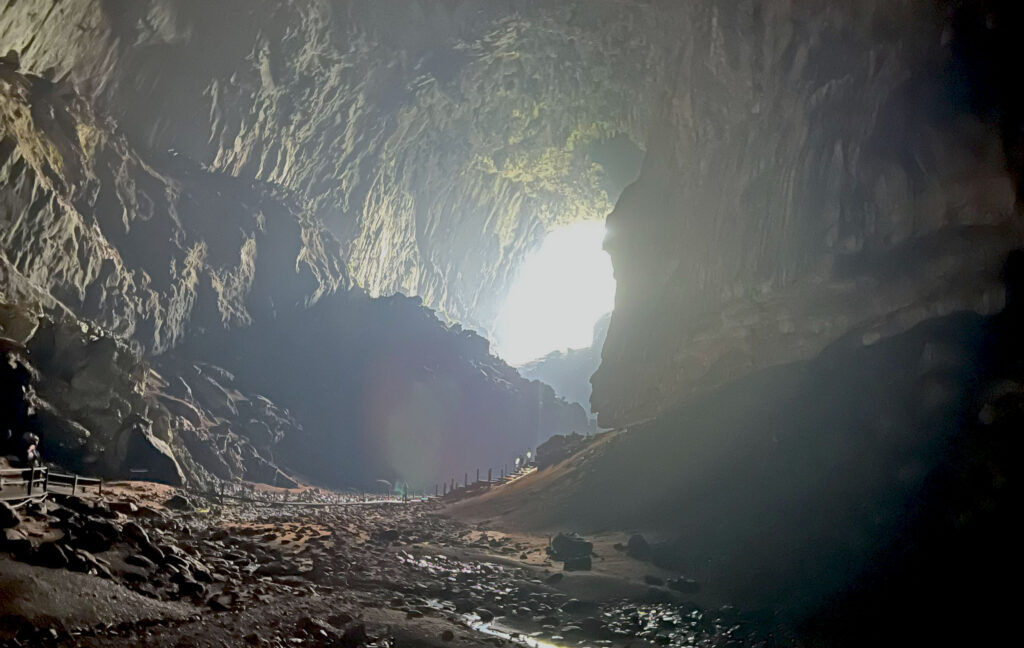To say that the three-month around-the-globe business trip that I recently completed was amazing would barely scratch the surface. This breathtaking journey involved an unforgettable juxtaposition of work and learning in the numerous and diverse cultures where I held the workshops.
To share one such experience, after the completion of a workshop in Malaysia, I visited Gunung Mulu National Park to explore the jaw-dropping Mulu caves. (Zoom in on the picture of Deer Cave to find the people to understand why I chose the phrase, “jaw-dropping.”) These caves are a UNESCO World Heritage site and are home to some of the world’s largest and longest caves.

My poor guide. He is a member of the Penan tribe, one of the last nomadic hunter-gatherer tribes in the world. Fascinated by a culture so different from mine, I peppered him with questions such as whether they had a religion (they do not), how young children learned to hunt with the blow pipe (they start out on squirrels and use arrows with no poison), did the tribe have a leader (a speaker, yes; a leader, no), how did they resolve conflicts (if the conflict got bad, they would move apart from each other), did the women hunt as well (they did), and how did the hunters avoid getting lost in the dense rain forest (they had some tricks, but many still get lost temporarily from time to time!).
Business colleagues, my drivers in Brazil, my tour guide in Kuala Lumpur, hikers, and others I met along the way faced a similar fate: workshop breaks, drives to destinations, and mealtime became an opportunity to learn about the history of where we were, the tension between individualism and collectivism, the differences in power hierarchies, and how they meet to eat when one does not eat beef and one does not eat pork. (Answer: meet at a KFC—everybody eats chicken!)
Once I got back to the United States and shared my experiences with friends, one remarked that I am an anthropologist at heart. I smiled at the comment and then realized how the feedback I received in the workshops reflected that insight.
In my workshops, I limit the size to small groups to encourage rich two-way conversations and ensure I can answer questions specific to each participant. But it’s always a bit of a class joke when a workshop participant asks a “How would you suggest handling [this or that]?” type of question, because I consistently respond with, “It depends.”
I do so because I know there are multiple variables that will influence my response. Answers to my questions such as “How does this group naturally make decisions? How are the differences of opinions expressed? How many people are involved in that conversation? Are you meeting virtually or face-to-face? What’s the conversation like when the leader is present? Is this an old issue or a new issue?” give me insight into the participant’s system.
Why bother understanding this? When it comes to good decision-making, decision-making tools and techniques, and pathways for implementation, there is not a “one size fits all” process. (See my past blog, Reverse Searing: Why NOT Following the Process Can Pay Off for more on this topic.) If you want to improve a given decision-making or operational process, if you want to re-engineer a process, you first must understand the system as it currently functions, and be able to articulate what that system preserves or achieves. Your initial governing question must be: “From a behavioral point of view, why does it make perfect sense that what is happening is happening?” as opposed to “How can I change this?”
Participants commented on my efforts to understand their systems and noted it in their feedback with comments such as “I need to step away from my biases and assumptions to better understand when is happening in depth before jumping to solutions.” A work colleague noted, “You are like an organizational anthropologist!”
Want to sharpen how you approach organizational change initiatives? Look at your teams or organization through the lens of an anthropologist.
Begin your initiative by asking the better questions that provide insight into the behaviors and beliefs of the system in which you are working. Get out of the right-wrong, good-bad mindset. You can neither understand nor appreciate a complex system through an evaluative lens. That way of seeing floods your brain with biases, dramatically narrows your vision of what exists and what can exist, and will quickly produce a “should” type of response-all of which leaves you swimming upstream against the prevailing cultural current.
By stepping away from your biases and assumptions, an anthropological approach will give you a deeper understanding of the proverbial lay-of-the-land. That invaluable insight, in turn, offers clues for solutions that better align with the existing cultural currents, thus making changes more implementable, effective, and sustainable.
